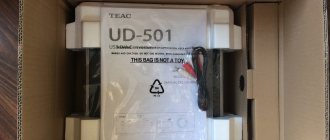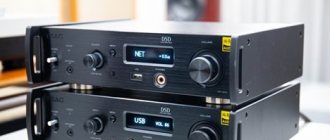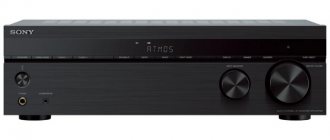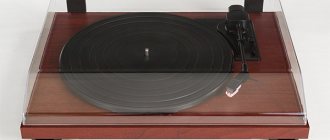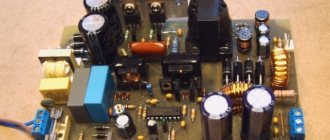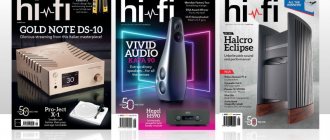Network player/USB DAC TEAC NT-503 deserves the highest rating
Due to its versatility, the TEAC NT-503 can be called a Swiss army knife in the world of Hi-Fi. This device includes a USB DAC with support for PCM 24 bit 192 kHz, DXD (24 bit 353 and 384 kHz), DSD64 and DSD128, a network player with support for 24 bit 192 kHz, a USB type A interface for playing music from a flash drive, a powerful amplifier for headphones.
TEAC is the world's oldest Hi-Fi manufacturer and is committed to being a leader in the world of digital audio. The Japanese manufacturer offers a wide range of individual DACs, most of which are stationary, but it also has a portable model, the HAP-90SD, and a mini Hi-Fi system, the CR-H101
In this article we would like to introduce you to the TEAC NT-503 network player. This is a relatively new device that shares many new features with the UD-503 DAC. Both devices look the same, have the same electronic core, and to a first approximation we can say that the TEAC NT-503 is a TEAC UD-503 DAC with an added network card.
A trained eye can still spot the differences between devices. On the front panel of the UD-503 there is a second 6.35mm headphone jack, which allows you to expand the functionality of the built-in headphone amplifier, for example, used to connect balanced headphones. Instead, the NT-503 has a USB A connector, which is repurposed for connecting USB flash drives with music. It should also be noted that there is a Bluetooth adapter with aptX support on the back of the device.
The NT-503 provides playback of all possible digital audio formats, both by connecting to a computer via a USB type B port, and over a network or from a USB drive - with the exception of DXD 353 and 384 kHz formats in the latter two cases. It is also possible to select the operating mode of the analog audio output - fixed level or adjustable. The NT-503 network player can become the basis of a Hi-Fi system, playing the role of a signal source and preamplifier. But it must be noted that the NT-503 can only be the basis of a digital system, since it does not have analog audio inputs, while the UD-503 has them and is located instead of a network card.
Appearance
The body of the TEAC NT-503 is made entirely of aluminum and is available in both silver and black colors. It gives the impression of a serious design and inspires confidence. The design of the player refers us to the successful Tascam line of professional audio equipment. Solid sides with handles, buttons and a retro toggle switch create a timeless, classic look.
To the right of the toggle switch is a mini jack 3.5 mm input connector, which can receive both an electrical S/PDIF signal using an RCA-mini jack adapter (supplied) and an optical S/PDIF signal (adapter not included). Above the described connector there is an external clock indicator. It lights up when an external high-precision generator is connected.
Next comes the input selector knob, which is also used to navigate through the menus, and the menu selection button; below it is the remote control receiver window.
The top line of the display shows the selected input, oversampling mode and digital filter settings. The second line displays the digital audio format and its bitrate, as well as the volume level in the case of a preamplifier or headphone amplifier. If a mode with a fixed level on the audio output is selected, then rotating the volume control has no effect, but when you connect headphones, the volume control changes their sound volume. It is also possible to set two fixed signal levels at the linear output - 0 dB (2 V) and +6 dB (4 V).
Under the screen there is a USB type A connector, which allows you to connect drives with audio files and a standard 6.3mm headphone jack.
Connection
The rear panel contains the power connector and three digital audio inputs. These are USB type B (used to connect the device to a computer), coaxial S/PDIF and optical S/PDIF. Next to them is a BNC connector for connecting a high-precision 10 MHz clock. At the bottom there is a plastic plug for the Bluetooth antenna, which protrudes slightly from the body. This is done specifically for better reception of electromagnetic radiation.
The RJ-45 port is designed for a wired connection to the network; underneath there are audio outputs - balanced XLR and unbalanced RCA. It should be noted that they cannot be used both at the same time. The polarity on the XLR connector pins can be changed through the settings menu.
What is inside
Opening the lid, you can find that the main sound card, the USB interface card and the power supply with two toroidal transformers are exactly the same as the UD-503.
The USB interface is located on a small separate board and includes a DSP (digital signal processor) on a Texas Instruments TMS320C6748B chip and a USB type B port (compatible with USB 1.1 and USB 2.0) soldered on the board, which is used to connect to a computer.
Another Texas Instruments TPS6507O chip provides 5V power to the board below. It contains an S/PDIF interface controller based on the Burr-Brown PCM9211 chip, which provides signal transmission with a bitrate of up to 24 bits 192 kHz.
On this board you can also find the Xilinx Spartan XC6SLX25 programmable FPGA matrix, on the basis of which the developed TEAC DSP is implemented, used for signal resampling and conversion of the digital stream to the DSD format (see diagram below). To the right of the FPGA is the microcontroller.
Below, to the left of the display you can see the Rayson BTM760 Bluetooth module with a protective cover. It supports the aptX codec.
The network board contains a Micrel KSZ8081 transceiver, a Texas Instruments D830K013DZ signal processor, and a Renasas V850 microcontroller.
On the same board, but on the other side, there is a memory chip containing microprogram code. It is marked “NT-503”.
On the largest board there is the main path, built according to a dual mono circuit. In the power supply circuit of the headphone amplifier you can see two pairs of 4700 µF/15 V electrolytic capacitors.
For each channel, an Asahi Kasei AK4490 DAC chip is used, which belongs to the Audio4pro line, specially designed for professional equipment and High End. This DAC is capable of decoding PCM streams up to 32-bit 768 kHz and DSD streams up to 11.2 MHz, both native and DSD-over-PCM. The DAC output filters are built on Muses8820 chips, developed by JRC (New Japan Radio Company) specifically for working with audio signals.
To adjust the sound, each channel uses its own JRC NJW1195 electronic potentiometer, which operates in differential mode with high accuracy.
Each channel includes two headphone amplifiers (they also boost the line output). One amplifier provides forward amplification, and the second provides a phase inverted signal, this is used to operate the balanced output. Each channel contains a Texas Instruments N5532 op-amp for voltage amplification and a complementary pair of 2SCR543 and 2SAR543 transistors for power amplification. These transistors are capable of dissipating 1 W of power each with passive cooling.
Use and listening
The main unit comes with an excellent remote control, but to fully control the player, you'll need to install a separate smartphone app (TEAC AVR Remote), which is available for both Android and iOS. It is quite convenient and intuitive.
We listened to the player in different modes - via a USB connection (we used the Foobar2000 software player and the TEAC HR Audio Player, it can immediately play files in DSD format, without additional configuration), via a network connection and from a USB flash drive. In all three cases, we enjoyed excellent sound from both speakers and headphones. We also tested the NT-503 in preamp mode by connecting it to a NuForce STA-100 power amplifier.
Magnificat by Arnesen (test file DSD128 2L.no) was played with infinite tenderness and graceful vocals. There was a lot of “air” in the sound, which gave lightness and increased the sound stage. It was truly beautiful.
There was much more rhythm and dynamics in Grieg’s “In the Cave of the Mountain King” performed by the Berlin Philharmonic Orchestra conducted by Jeffrey Tate. But during listening, it was noted that the manner of performance became less expressive than usual. This does not mean that the sound was sluggish, but the NT-503 tended to soften the sound slightly.
George Harrison's psychedelic composition Isn't It A Pity from the album All Things Must Pass performed by TEAC NT-503 causes a complete overdose, but in a good sense of the word.
I would like to note that the headphone amplifier has a good volume reserve. The sound in the headphones is very comfortable even at a volume level of -30 dB.
We listen to the composition Half Ladies from the album Chaleur Humaine by Christine and the Queens. We receive incomparable pleasure. The performer's voice is very soft and gentle, and it can be heard quite clearly against the background of the bass accompaniment, which is in abundance on this composition.
Listening to music via Bluetooth aptX shows good results. The sound quality is very close to the sound of uncompressed 16-bit 44.1 kHz files.
Conclusion
In conclusion, we can say that the TEAC NT-503 network player is one of the strongest players in the market. It has an excellent DAC, network operation, and exceptional ability to decode all kinds of audio file formats. It also provides high quality sound when used as a preamp and as a powerful headphone amplifier. Recommended for purchase.
Based on materials from Qobuz.com Author Barry Moore
Teac UD-503 vs Inntak Saber ES9018
Teac is a pretty serious competitor in the world of audiophile sound. Its products under the Esoteric brand are heard by the most sophisticated music lovers. The prices are also appropriate. But Teac rests not only in heaven in a crystal castle, but also produces some models of its products for mere mortals. In the initial segment, some time ago it pleased audio fans with the Teac UD-301 DAC model, built on 2 PCM1795 chips.
I listened to this model on large speaker systems from Troels Gravesen's project and it performed very well with a coaxial input.
The USB input, unfortunately, was not of high enough quality. My second acquaintance with DACs “for ordinary people” happened thanks to the Teac UD-503 model, which ended up in my setup and allowed me to compare it to my heart’s content with different combinations of amplifiers and DACs.
Teac UD-503 is not an ordinary DAC; everything in it is done according to the latest Feng Shui. The advertising review states the following (advertising text here and below is italicized):
The TEAC UD-503 is a premium USB/DAC/headphone amplifier with a dual-mono architecture that delivers superior performance through a range of technologies and circuitry derived from high-end Esoteric components.
It is based on two AK4490 chips, which are declared as VELVET SOUND (“velvet sound”). And usually these chips actually produce a thicker and more “pulling” sound, but not in this case.
Low Distortion Technology delivers a signal-to-noise ratio better than 112dB S/(N+D), the industry's highest achievement for a 120dB-class DAC.
In addition to playing back DSD streams with native resolutions up to 11.2MHz (Native playback), the UD-503 also supports a wide variety of Hi-Res sources, including 32-bit/384kHz PCM. The smoothness of detail and outstanding precision of sound source placement are reproduced to the extremes of Hi-Res Audio. The AK4490 DAC is a product of the Audio4pro™ brand developed by Asahi Kasei Microdevices Corporation for professional audio equipment and high-end digital audio components.
The UD-503's best-in-class performance is based on fully balanced dual mono circuitry. From the power supply to the DAC chips and to the analog output stages, the element base is a mirror pair of perfectly matched components. A pair of high-efficiency toroidal power transformers and high-quality VERITA AK4490 DAC chips, for example, operate as a single mono circuit on each channel, preventing cross-talk between audio signals.
When connected via USB, the UD-503 supports asynchronous data transfer, allowing you to fully control PCM and DSD signals with its own clock signals from precision quartz clock generators. The UD-503 is equipped with two clock generators - one each for frequencies that are multiples of 44.1 kHz and 48 kHz. There is also a 10 MHz external clock input that allows you to connect the DAC to a higher-end Esoteric generator or GPS clock for calibration or continuous use.
The UD-503 uses TEAC's latest Field Programmable Gate Array (FPGA) with its exclusive Fluency boost algorithm. In addition to upsampling PCM encoded data at 2x, 4x, and 8x, it also supports upconversion of DSD streams up to 12.2MHz (4x DSD). Thanks to this unique system, the UD-503 converts 16-bit/44.1kHz data from conventional CDs into an 11.2MHz DSD stream—256 times faster. Audio data with frequencies above 20kHz is generated using an interpolation algorithm to restore natural sound as close to the original as possible. As a result, even when listening to CD or MP3 recordings, the listener receives a feeling of “atmosphere” of performance or “air” that is usually inherent only in the DSD format. Audio files in 48kHz PCM format can be played back as a 12.2MHz DSD stream after conversion.
In addition to four types of digital filters for PCM encoded streams and an OFF mode, the UD-503 has two types of digital filters for DSD streams. You can select the best filter for each input file format or type of music. The listener will be able to enjoy the subtle nuances of sound with different filters without the need to connect different USB/DACs. For PCM there are: FIR SHARP, FIR SLOW, SDLY SHARP, SDLY SLOW, and for DSD there are two cutoff frequencies CUTOFF: 50kHz or 150kHz.
Between the digital and analog sections, the UD-503 uses a Digital Isolator to completely isolate each power and ground path. It prevents all noise from digital sources, in particular from computers connected to the USB input, from entering the analog part through power supply or grounding channels. This isolation scheme offers significant benefits, particularly for high-resolution audio playback where sources have higher sampling rates. The UD-503 is the first product in the Reference series to offer this feature.
The UD-503 features separate toroidal power transformers for the left and right channels, which deliver clean and stable current regardless of the dual mono concept. Each power supply provides a stable supply current to its channel and is not affected by changes in the current consumption of the other channel.
Based on TEAC's many years of experience in high-end audio design, the analog amplifier section operates a pair of discrete high-current buffer amplifiers. TEAC-HCLD (High Current Line Driver) circuitry on each channel improves transient response during differential processing in balanced mode and parallel processing in unbalanced output mode. As a result, the UD-503 provides a wide dynamic range of source signal high resolution without losing the dynamism of the music.
The UD-503 has a built-in high-quality headphone amplifier that provides 700MW+700MW output power. “TEAC-HCLD” circuits with four output transistors operating in parallel mode make ordinary headphones sound powerful and accurate. In addition, the amplifier's exclusive Class AB design and extended Class A operating range allow the HT-503 to operate primarily in A-mode, maximizing its performance potential for a wide variety of headphones, including high-impedance headphones up to 600 ohms. .
The company pioneered a new headphone connection method, the active ground drive, which uses the same connection as a balanced connection, but forces the COLD pin to remain at a stable 0V level using an amplification circuit that shorts the COLD to " land." Due to this, not only does the ground potential become closer to ideal than in a conventional circuit, but the background influence from the power source is also suppressed. Since the noise level becomes much lower, you can hear the most subtle textures of the sound of recordings, right down to the breathing of the performers.
The three-point support method used for the housing supports ensures stable installation regardless of uneven surfaces. An ingenious design that combines spiked supports with an extended stand leg is used for each of the three legs. This allows you to reduce the influence of vibrations and resonances, and completely eliminate heaviness and “turbidity” at mid and low frequencies, improve resolution, increase sound detail and the accuracy of placement of sound objects. Although point supports are ideal for audio equipment, their installation was previously extremely difficult, with the help of the new design it has been greatly simplified.
To play DSD streams with a frequency of 11.2MHz, there is a free application “TEAC HR Audio Player”, which runs on Windows or Mac. All next generation audio sources can be connected immediately (only for Windows computers you need to install a driver).
- USB DAC supporting 11.2MHz DSD Native playback and 32-bit/384kHz PCM
- Dual mono circuit design, from the power supply to the DAC chips and to the analog output stages
- Two AK4490 DAC chips from Asahi Kasei Microdevices Corporation
- Separate toroidal power transformers for left and right channels
- Digital Isolator circuit for galvanic separation of digital and analog sections
- Four buffer amplifiers “TEAC-HCLD” Quad Buffer Amplifier with high current output
- Upconversion to 12.2MHz DSD and 384kHz PCM using FPGA chips
- Two DSD options and four PCM filters for a choice of sound options to suit your tastes
- 10MHz External Clock input for more accurate timing (USB Asynchronous mode only)
- Two precision clock generators for frequencies that are multiples of 44.1kHz and 48kHz (USB asynchronous mode only)
- One pair of analog unbalanced RCA inputs
- Balanced XLR and unbalanced RCA line outputs with fixed (+6dB) or variable output
- Polarity switching on XLR outputs (2:HOT or 3:HOT)
- "TEAC-QVCS" Precision Volume Control Circuits
- Large volume indicator on a bright OLED display (3-step dimmer, plus Off switch)
- Fully balanced discrete headphone amplifier with 700mW + 700mW output power
- Three headphone amplifier operating modes: balanced, unbalanced and active ground
- Rear-panel coaxial and optical digital inputs plus USB port
- Combined coaxial-mini/optical-mini front panel digital inputs for portable digital audio devices
- Low power consumption, Auto Power Saving function
- Durable and elegant all-metal A4 housing protects against external vibrations and noise
- Original design of three-pointed supports for the body
If you carefully read all the advantages and capabilities of this device, then what is certainly described is very cool, however, the price tag for this DAC is currently 108,000 rubles ($1646).
Therefore, we will not beat around the bush and compare with Chinese non-serial amplifiers (diy), rather very small-scale ones, which, as usual, have exorbitant price/sound ratios. Namely, the competitor will be a Chinese DAC, which has long been used as the basis of my audio system - Inntak Saber ES9018 + 2x Muses 8920 + 2x AD797 + 2x-RCore + Amanero.
This is also a DAC with dual separate power supply (two transformers), it is also balanced, and so on. The difference is that the Inntak uses the flagship Saber ES9018 DAC, while the Teac uses the flagship AK4490 DAC. At the moment, both chips are already former flagships, they have been supplanted by new models - AK4497 and Saber ES9038, but still.
There is a lot of information about the DAC from Inntak on the website. Regarding the Teac UD-503, I will say that the device has balanced outputs, has many filters and operating modes. Its appearance is quite neat and beautiful, but the 3 legs on the bottom are somewhat out of place and it seemed to me, when I moved the device, that they seemed to be “dangling”. The DAC has a remote control from which you can select different operating modes and inputs (RCA, XLR). The Teac DAC can also be a headphone amplifier and preamplifier with a convenient volume knob.
LISTENING PATH
Listening was carried out on several amplifiers, namely:
Exposure 3010 (power amplifier + relay volume control, price for a similar model is 100,000 rubles)
Nec A-700 (integrated amplifier, no longer available)
Parasound A23 (power amplifier, current price 95,000 rubles, $1450)
TPA3255 is a Class D dummy amplifier.
The following acoustic systems were used.
Diatone DS-77Z - floor-standing 3-way speaker systems, 3W
Onkyo D-302e (1600 euro) - bookshelf 2-way speaker systems, slot-type FI.
Everything was switched with Chinese McIntosh 2328 clone cables (both balanced and unbalanced), which I liked from a fairly large number of contenders.
LISTENING TO TEAC UD-503
The sound of the Teac UD-503 (2xAK4490) was somehow checked against the Inntak DAC (ES9018). In the settings of the Teac UD-503, all filters or upsampling were turned off, which, as you understand, affects the sound. If you experiment with the settings, then this entertainment will take you a lot of time, since you can use 2x, 4x, 8x oversampling exactly (maybe more - I didn’t go into it - I’m describing what I saw on the DAC screen), you can turn on different low- pass filters or even use NOS. This is certainly a wealth of settings variability, a big plus of the device. What is described below concerns only the mode without oversampling and filters, which is preferred for listening by the real owner of this device.
The sound of the Teac UD-503 is very detailed. The space is well designed, you will immediately feel the three-dimensionality of the sound. Of course, this also depends to some extent on the amplifier, since it should not make big changes to the sound paradigm. But here the amplifiers usually pull the blanket to their side.
Exposure 3010, having a channel separation of only 60dB, naturally cannot show audiophile-accurate three-dimensional space, compensating for this with a very melodious and soulful performance, when the music simply pours into your ears with minimal desire to analyze something.
The Nec A-700 shows a ton of resolution, while the Parasound A23 turns out to be more balanced in all aspects. It doesn't have the same resolution record as the Nec A-700, but its resolution is still extremely high and the 3D sound image is amazing.
Of course, there is a matter of taste and the listener himself selects an amplifier to his taste and there is no need to force anyone to his paradigm.
So, the sound of the Teac UD-503 is detailed, three-dimensional and quite bright - it is definitely not a dull or dark DAC, and high resolution is undoubtedly achieved as a result of using a pair of AK4490, separate power supply (two tori) and high-quality operational amplifiers.
Teac UD-503 plays great, but while you are listening to Hi-Res - 192K/24 or 96K/24 bit. It’s worth switching to the classic 44.1/16, a widely used CDDA, and questions arise. Iron appears in the sound. These iron notes can also be described as “digital” or “synthetic”. That is, this is not good.
I listened to this particular copy with the photo
Let me remind you that the Teac UD-503 has many settings and perhaps this negative effect can be eliminated to some extent by selecting low-pass filters and/or oversampling, but there is such a problem.
In comparison, Inntak plays both Hi-Res and regular 44.1/16 recordings equally well, and it is extremely difficult to distinguish them by ear, except perhaps by their different volume levels.
If you slip Teac UD-503 recordings at 192000 Hz 24 bits, you won’t recognize it - it plays them without defects.
What is the global difference between Teac UD-503 and Inntak Saber ES9018. Technically, you understand that these are completely different devices - the first is on two AK4490 chips, and the second is on Saber ES9018, etc.
Nevertheless, the overall sound class of these devices is comparable - these are DACs of the same class, but offering different interpretations of the same material.
The owner of Teac UD-503, when listening to the Inntak Saber ES9018, described its sound as “softer”, and this was regardless of the bit depth and sampling rate of the musical material.
Repeatedly switching the sound from Teac UD-503 to Inntak, I eventually identified the main points of difference between them.
Teac UD-503 draws 3D space more accurately and clearly, it seems that you can distinguish more details. This is achieved by some protrusion of the middle range, but at the same time the sounds appear to be emasculated in thickness, they are thin in body, which is not as deep and textured as it should be.
This is how Teac UD-503 draws music
Inntak produces sound quite thick, transparent and airy.
This is how Inntak
The sound has a full body, which has a beneficial effect on audio visualization, while the Teac has a “skinny body” of the midrange that begins to compete with other frequency ranges, which is inappropriate and does not create a better audio picture. Overall I liked both DACs. With the Teac UD-503 you can feel quite good, although you limit yourself either to high-cuts or by playing with filters (perhaps the disadvantages I described are just the reason that I did not include some successful filters and oversampling), but if I had considering an exchange offer, then I would not exchange my Inntak for Teac. It’s not that the Teac is worse, it’s not, the devices are completely in the same class, but the Inntak plays perfectly not only Hi-Res, but also 44.1/16, and its interpretation of music is closer to me.
The sound also varies greatly in character. With Inntak, you seem to see a little from a distance a three-dimensional room filled with air. With Teac, you literally press your nose into the musician's violin (the midrange sticks out in your face).
The digital quality of the 44.1/16 format performed by the Teac UD-503 can be corrected by less radical methods, for example, the selection of acoustics - in particular, the performance with the Teac UD-503 in the Onkyo D-302e, which is characterized by softening the edges of the sound, gave a natural and beautiful sound, although not as voluminous as it appears on the Diatone DS-77Z.
The Teac UD-503 is certainly a DAC with good resolution and other advantages, but it seems to me that it focuses more on analyticality and three-dimensionality than on the notorious “musicality”.
Characteristics of the network player TEAC NT-505
| DAC | two VERITA AK4497 chips (32 bit/768 kHz PCM, 22.5 MHz DSD) |
| Upsampling | switchable, PCM: 2x, 4x, 8x up to max. 352.8/384 kHz; PCM to DSD (up to 22.5/24.5 MHz) |
| Filters | PCM: Sharp Roll Off, Slow Roll Off, Short Delay Sharp, Short Delay Slow, Low Dispersion, off; DSD: Narrow: 39 kHz (2.8 MHz), 78k kHz (5.6 MHz), 156 kHz (11.2 MHz) or 312 kHz (22.5 MHz), Wide: 76 kHz (2.8 MHz) , 152 kHz (5.6 MHz), 304 kHz (11.2 MHz) or 608 kHz (22.5 MHz) |
| Frequency range | 10 Hz – 80 kHz (+ 1 dB, – 3 dB, 192 kHz PCM input, RCA output, digital filter disabled) |
| Signal to noise ratio | 110 dB (192 kHz PCM input, RCA output, digital filter disabled) |
| Harmonic distortion | 0.002% (192 kHz PCM input, RCA output, digital filter disabled) |
| Output impedance | 188 ohms (XLR), 150 ohms (RCA) |
| Output voltage | XLR: 2 V (1 kHz, 10 kΩ, fixed, 0 dB), 4 V (1 kHz, 10 kΩ, fixed, +6 dB), 12 V (1 kHz, 10 kΩ, variable); RCA: 2 V (1 kHz, 10 kΩ, fixed, 0 dB), 4 V (1 kHz, 10 kΩ, fixed, +6 dB), 6 V (1 kHz, 10 kΩ, adjustable) |
| Maximum headphone amplifier output power | 2x500 mW (32 Ohm) |
| Supported headphone impedance | 16-600 Ohm |
| Supported formats for playback via local network and USB for external drives | PCM up to 24 bit/192 kHz, DSD512 (22.5 MHz) |
| Supported Web Services | TIDAL, Qobuz |
| Roon Ready Certification | There is |
| Bluetooth | version 4.0, profiles: A2DP, AVRCP, codecs: LDAC (24 bit/96 kHz), Qualcomm aptX-HD (24 bit/48 kHz), aptX, AAC, SBC, max. number of connected devices: 8 |
| App control | supported for iOS and Android devices |
| Inputs | 3.5mm Hybrid (Coaxial/Optical, 24bit/192kHz, DSD 2.8MHz (DoP)), USB (Type A, Front, PCM up to 24bit/192kHz, DSD up to 22.5MHz ), coaxial (24 bit/192 kHz, DSD 2.8 MHz (DoP)), optical (24 bit/192 kHz, DSD 2.8 MHz (DoP)), asynchronous USB Type B (up to 32 bit/768 kHz PCM, up to 22.5 MHz DSD, supports Bulk Pet technology), Ethernet port (LAN) |
| Exits | Linear RCA (fixed/variable), balanced XLR (fixed/variable), 3.5mm headphone jack (16-600 ohms) |
| Other switching | BNC input for external 10 MHz clock generator |
| power unit | two toroidal transformers (one per channel) |
| Display | OLED dimmable, switchable |
| Remote control | RC-1330 |
| Software player | TEAC HR Audio Player (Windows, Macintosh), included, allows you to play Hi-Res audio in DSD512 and PCM (32-bit/768 kHz) formats |
| Streamer app | TEAC HR Streamer (Windows, Macintosh), included, controls audio streaming from a variety of devices, computers, NAS servers and the Internet, supports DSD 5.6 MHz and PCM up to 192 kHz |
| Power consumption | 18 W, standby: 0.4 W |
| Dimensions (WxHxD) | 290x81x249 mm |
| Weight | 3.9 kg |
With hands, but not a clock
Connect and listen
During the audition, which took place in the office of a Russian distributor, we alternately used B&W 606 Anniversary Edition and Castle Avon 4 speaker systems, all switching was performed with AudioQuest digital and analog cables.
First, let's say a few words about how well (or poorly) the AP-505 power amplifier works with each of the speaker models used. It must be said that there were no special surprises - from the point of view of bass control and the maximum available reserve of undistorted volume, the best combination was with bookshelf monitors from B&W, while floor-standing speakers from Castle, which generally have high resolution and overload capacity, clearly require more powerful partner. To really get them going - and they more than deserve it, great potential is heard from the first notes - you will probably need two TEAC AP-505s turned on in bridge mode. So the assembled system confirms its “office” character, but only in terms of power, because in all other respects it is a real miracle.
Since we were especially interested in the effect of including an external clock generator in the system, the main listening material was files from a local server received over the network. Perhaps, it is especially important for them to ensure accurate timing characteristics of the signal, taking into account many variables when transmitting them over long distances. Activation and deactivation of the generator is done through the TEAC NT-505 menu, and the fact of receiving a synchronizing pulse from the TEAC CG-10M-A is confirmed by a blue LED on the front panel of the streamer.
Without turning on an external quartz oscillator, the combination of TEAC NT-505 and TEAC AP-505 demonstrates a very airy and, at the same time, rich in detail sound, a little relaxed and conducive to contemplative listening. The resolution is enough to admire all the subtleties of sound production in classical music, as well as confidently distinguish between groups of instruments in an orchestra and voices in a choir. From a formal point of view, there is absolutely nothing to complain about. Or is there still something to it? This becomes obvious after connecting a proprietary clock generator to the circuit. The sound instantly transforms, and exactly in the direction that was expected. Yes, all the audiophile bells and whistles remain in place, but the sound of the system has an inexorable sense of rhythm that simply makes the listener tap his foot to rock and disco music - Michael Jackson's hits sound exactly like on the original vinyl record, and the heartbeat is in everything With “The Dark Side of The Moon,” Pink Floyd comes to the fore. Orchestral works begin and win - now you no longer want to look for the position of the drum group in space, but take the conductor’s baton in your hands and pretend that you are the one who makes all the musicians play so harmoniously and together.
However, as soon as you turn off the TEAC CG-10M-A, the disco with concerts instantly ends, and the gray audiophile everyday life begins. Let’s face it, it’s hard to imagine a more convincing demonstration of the positive effect of including a high-quality clock generator in a digital system.
Ratings
| + | Truly live sound paired with an external generator, excellent equipment, stunning appearance | — | There are still power limitations |
Design
100
Workmanship 100
Sounding 95
Functions 95
Total 95
Conclusion:
Of course, the TEAC CG-10M-A generator is not cheap, and in principle, you can listen to music on this system without it, but how good is it! It is his presence that transforms a small cabinet stand into something much larger. Combined with good bookshelf monitors, these three will make you forget about big components.
Alexander Chechelev
December 2, 2022
Editorial staff of Hi-Fi.ru
